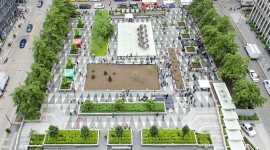Polishing the Jewel: Mellon Square
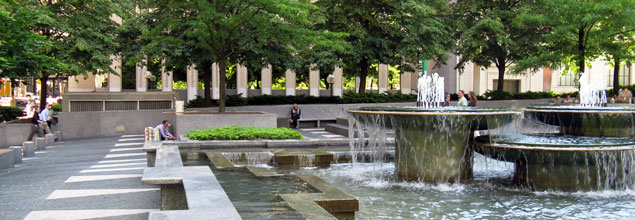 Mellon Square photo by Charles Birnbaum, 2010
Mellon Square photo by Charles Birnbaum, 2010
We are pleased to announce the publication of Mellon Square: Discovering a Modern Masterpiece by Susan M. Rademacher. This second volume in our Modern Landscapes: Transition and Transformation series with Princeton Architectural Press, focuses on historically important midcentury works that have undergone significant change.
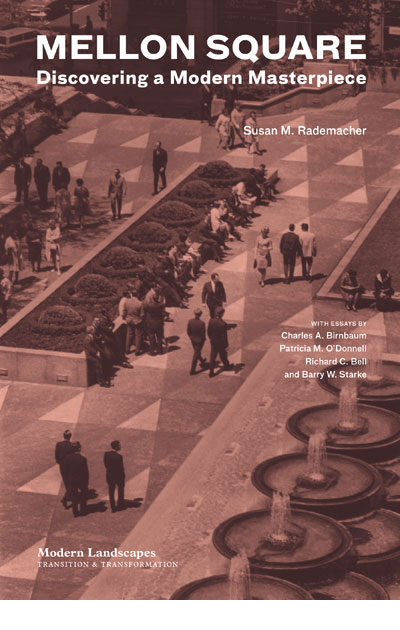 In Mellon Square: Discovering a Modern Masterpiece, author Susan M. Rademacher chronicles the planning and design motivations behind the development of Pittsburgh’s Mellon Square, the first Modernist garden plaza built over a parking structure. This rich narrative illuminates the history, recounts its recent restoration, places it within its historical design context, and, raises awareness of this midcentury landscape treasure, its inherent vulnerability, and historic preservation needs. According to Patricia M. O’Donnell, FASLA, AICP, who in partnership with The Pittsburgh Parks Conservancy and the City of Pittsburgh led the restoration which was completed in 2014: “Approaching the work of a master requires insight and humility. An understanding of original design intent and execution is paramount … Mellon Square’s transcendent character is palpable once again.”
In Mellon Square: Discovering a Modern Masterpiece, author Susan M. Rademacher chronicles the planning and design motivations behind the development of Pittsburgh’s Mellon Square, the first Modernist garden plaza built over a parking structure. This rich narrative illuminates the history, recounts its recent restoration, places it within its historical design context, and, raises awareness of this midcentury landscape treasure, its inherent vulnerability, and historic preservation needs. According to Patricia M. O’Donnell, FASLA, AICP, who in partnership with The Pittsburgh Parks Conservancy and the City of Pittsburgh led the restoration which was completed in 2014: “Approaching the work of a master requires insight and humility. An understanding of original design intent and execution is paramount … Mellon Square’s transcendent character is palpable once again.”
Susan M. Rademacher, author of the book, says “Mellon Square grabs you—with its rich layers of meaning, it rewards discovery with story upon story of a city’s aspirations, an unlikely political partnership, a business district’s rebirth, a groundbreaking design approach, a pioneering collaboration, a rooftop plaza, and the struggle to maintain it.”
Editor’s Foreword
Charles A. Birnbaum, FASLA, FAAR
The second monograph in the Modern Landscapes: Transition and Transformation series is dedicated to Pittsburgh’s Mellon Square, built in 1955 and the first Modernist garden plaza in America to be built over a parking garage. Designed by landscape architects John Ormsbee Simonds and Philip Simonds, of Simonds & Simonds, in collaboration with architects James A. Mitchell and Dahlen K. Ritchey, of Mitchell & Ritchey, the plaza was paid for by the Mellon family foundations and conceived as an urban oasis—a public gathering space nested within a cluster of buildings by prominent architects, including Daniel H. Burnham (the Greek Classical Oliver Building) and Harrison & Abramovitz (the Modernist Regional Enterprise Tower, formerly called the Alcoa Building). The plaza was a cornerstone of the Pittsburgh Renaissance, an initiative established by the Pittsburgh Regional Planning Association at the end of World War II to transform the industrial downtown area into a modern city composed of plazas, parks, and new corporate buildings.
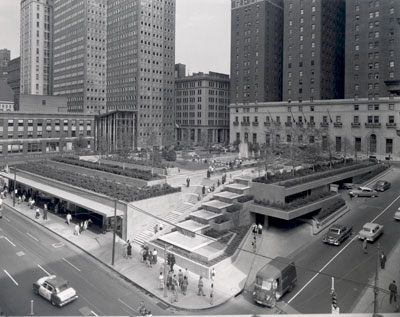
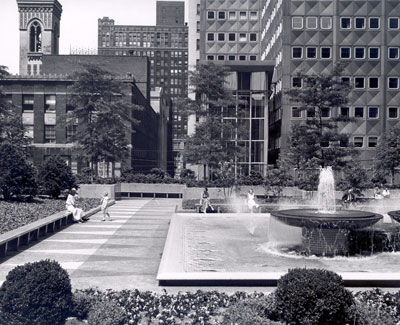
(upper) Lifting the plaza above the street extended the civic
space to the facades of surrounding buildings; (lower) The
parking facility, retail space, and rooftop plaza were conceived
as a single design. Photos from Mellon Square: Discovering
a Modern Masterpiece.The example of Mellon Square contrasts strongly with the first site in this series, Lawrence Halprin’s Skyline Park in downtown Denver, where stewards placed little or no value on its original design, resulting in a disastrous alteration. In contrast, Mellon Square’s unique and historically significant design intent and Modernist character have been very well chronicled, documented, and analyzed, which has informed the project work in this book. The result: a renewed, enhanced, and revitalized Mellon Square that carefully balances the highest historic preservation standards with clearly articulated performance benchmarks and sustainability standards.
Mellon Square is also distinct within a national context. Unlike many other Modernist works of landscape architecture that have met an untimely demise due to decades of deferred maintenance, Pittsburghers have never fallen out of love with Mellon Square, even when it was in a diminished state. I learned this firsthand in 2007 when the Pittsburgh Parks Conservancy invited me to lecture about the iconic plaza in order to energize local business leaders and champions of parks and open spaces. The effort was not difficult, because the local design community valued this nationally significant work. What we discovered at a symposium dedicated to Simonds two years later was how strong and deep of a bond Pittsburghers, as well as landscape architects throughout the country, had with Mellon Square.
Upon reflection today, in preparing for and delivering that initial lecture in 2007, I learned a number of things. First, during Mellon Square’s previous renovation in 1989, a then-retired John Simonds was brought back to consult, via his successor firm, Environmental Planning & Design (EP&D). This collaboration differed from other situations where the original landscape architect was never asked to consult (e.g., Lawrence Halprin in Denver, Dan Kiley at Lincoln Center), and suggests that Simonds’s design legacy, and the designer himself, was held in high regard (even though we have since learned that Simonds and EP&D weren’t in agreement with some of the design changes made at the time).
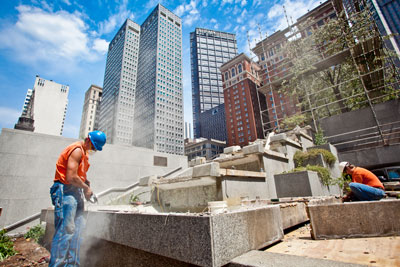
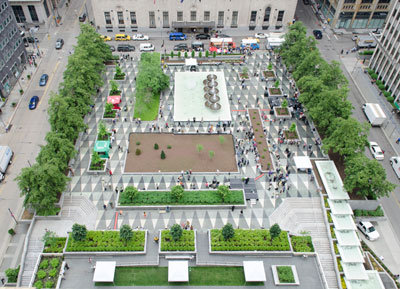
(upper) Mellon Square, photo copyright Richard Schiavoni;
(lower) Restoration work at Mellon Square.Second, unlike many other landscape architects of the postwar years, Simonds published extensively throughout his entire career, thus making his design approach and specific design recommendations for Mellon Square clear and accessible. Recognition of Simonds’s contributions to the cityscape was boosted by the listing in late 2013 of the Allegheny Commons on the National Register of Historic Places, which included substantial 1960s Simonds & Simonds designs, such as the once-threatened and extraordinary trapezoidal-shaped Lake Elizabeth. The designation is all the more important because, as the city’s oldest mapped parkland, the period of significance spanned a century, from 1868 to 1967.
Finally, in a match made in heaven, the adoption of Mellon Square by the Pittsburgh Parks Conservancy (founded in 1996) helps to write a new chapter in the Pittsburgh Renaissance. The Conservancy is the go-to nonprofit partner in restoring and managing public parks. Their efforts, which cannot be understated, are unlike similar regional organizations that were founded around Olmsted-centric networks of parks and boulevards (e.g., Louisville, Buffalo, and Seattle). Here, under the project management of their parks curator (the first such position for a parks organization), the Conservancy broadened its portfolio beyond picturesque and naturalistic neighborhood-based parks to include a downtown site, the Modernist Mellon Square. In 2008, with lead gifts from the Richard King Mellon Foundation and the BNY Mellon, the Conservancy began work on a strategy for renewal. Led by landscape architect Patricia M. O’Donnell of Heritage Landscapes, the square now benefits from a comprehensive strategy for its preservation, restoration, maintenance, and programming.
Now that the jewel has been polished and the Conservancy’s curator, Susan M. Rademacher, has told the rich story behind its evolution, will the first Modernist garden plaza built over a parking garage in America achieve the highest honor that can be bestowed on a property in the United States—designation as a National Historic Landmark? Based on the admiration that Pittsburghers feel toward Simonds, one that I would place on the same emotional plane as another creative postwar son, Andy Warhol, I would suggest that it is just a matter of time.




